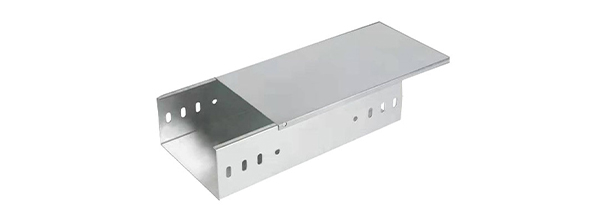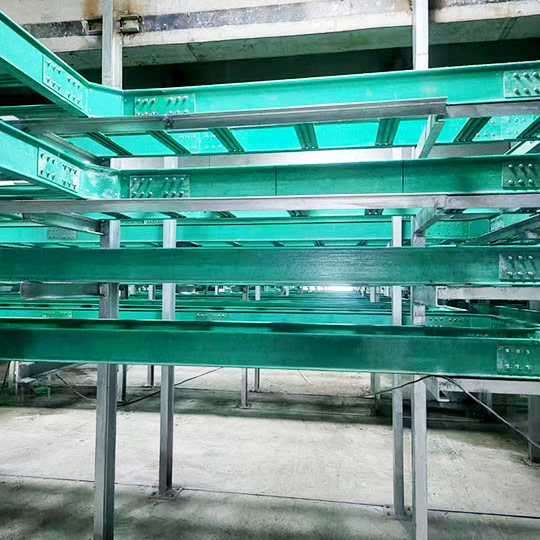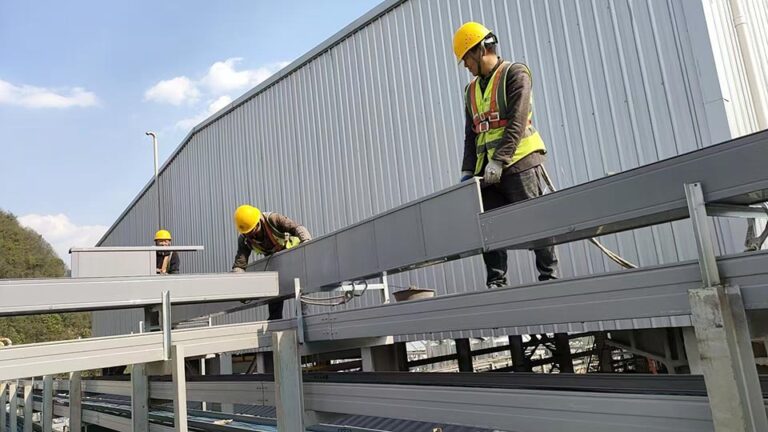What is an FRP Cable Tray?
An FRP cable tray (fiberglass reinforced plastic cable tray) is a non-metallic cable management system designed to support and protect electrical and communication cables. Unlike traditional steel or aluminum trays, FRP cable trays are lightweight, corrosion-resistant, and non-conductive, making them the preferred choice for harsh and demanding environments.
FRP cable trays are manufactured using fiberglass reinforced with thermosetting resins, such as polyester, vinyl ester, or epoxy, providing a combination of high mechanical strength and superior chemical resistance.
At YD Cable Tray, we design and supply high-performance FRP cable trays for chemical industries, offshore platforms, power plants, tunnels, and infrastructure projects worldwide.

Types of FRP Cable Trays
YD Cable Tray provides several FRP cable tray designs to meet different project requirements:

Trapezoidal FRP Cable Tray
- Designed with a trapezoidal cross-section for extra strength and rigidity.
- Provides excellent load-bearing capacity while keeping the weight low.
- Commonly used in industrial plants and power stations where heavy cables need stable support.
- Click the link to learn more

Trough Type FRP Cable Tray
- Features a fully covered trough design, protecting cables from dust, falling objects, and dripping liquids.
- Provides maximum shielding against environmental contamination.
- Suitable for chemical factories, food industries, and outdoor installations where safety is critical.
- Click the link to learn more

Tray Type Fiberglass Cable Tray
- The most versatile FRP tray design, combining strength and ventilation.
- Supports both power and data cables, with options for perforated or solid bottoms.
- Ideal for general-purpose cable management across commercial and industrial projects.
Trapezoidal vs Trough vs Tray Type FRP Cable Tray: Which One to Choose?
| Feature | Trapezoidal FRP Cable Tray | Trough Type FRP Cable Tray | Tray Type Fiberglass Cable Tray |
|---|---|---|---|
| Design | Trapezoidal cross-section for added rigidity | Fully enclosed trough design | Open tray design, can be perforated or solid |
| Load Capacity | ✅ High – suitable for heavy cables | Medium – supports light to medium cables | Medium – versatile for different loads |
| Ventilation | Partial ventilation | ❌ No ventilation (fully enclosed) | ✅ Good ventilation (if perforated) |
| Protection | Strong and stable, less shielding | ✅ Maximum protection from dust, liquids, and falling objects | Moderate protection |
| Best Application | Power plants, industrial projects with heavy cables | Chemical plants, outdoor dusty/corrosive environments | General-purpose installations in commercial & industrial projects |
| Durability | Excellent corrosion and UV resistance | Excellent, especially in harsh environments | Very good, suitable for most projects |
| Cost | Medium–High | High (due to protective design) | Medium |
Key Features and Benefits of FRP Cable Trays
FRP cable trays are not just an alternative to metal trays — they provide unique benefits:
- Corrosion Resistance → Resists salt spray, acids, alkalis, and harsh chemicals.
- Lightweight Design → Up to 40% lighter than steel, easier transport and installation.
- Electrical Insulation → Non-conductive, preventing shock hazards.
- Durability → Excellent UV stability, weatherproof for outdoor use.
- Low Maintenance → No need for galvanization, painting, or frequent replacement.
- Long Lifespan → Can last 30+ years in corrosive environments.

Applications of FRP Cable Trays
FRP cable trays are engineered for industries where durability, safety, and corrosion resistance are critical:
- Chemical and Petrochemical Plants → withstand acid and alkaline vapors.
- Marine & Offshore Platforms → resist saltwater corrosion and high humidity.
- Power Plants & Substations → manage high-voltage cables under extreme conditions.
- Transportation & Tunnels → lightweight solution for long-span installations.
- Food & Pharmaceutical Industries → hygienic, easy to clean, and non-corrosive.
- IT & Data Centers → suitable for fiber optic and low-voltage data cabling.
FRP Cable Tray vs Metal Cable Tray
Choosing the right cable tray depends on the environment. Here’s a comparison:
| Feature | FRP Cable Tray | Steel / Aluminum Cable Tray |
|---|---|---|
| Corrosion Resistance | ✅ Excellent | ❌ Prone to rust |
| Weight | ✅ Lightweight | ❌ Heavy |
| Electrical Insulation | ✅ Non-conductive | ❌ Conductive |
| Strength | Good | ✅ Higher |
| Maintenance | ✅ Minimal | ❌ Requires coating & painting |
| Lifespan | ✅ 25–30 years | 10–15 years |
| Cost | Higher upfront | ✅ Lower upfront |
How to Choose the Right FRP Cable Tray
When selecting an FRP cable tray, consider these factors:
- Environmental Conditions → Chemical exposure, outdoor use, offshore environments.
- Load Capacity → Weight and number of cables.
- Tray Type → Ladder, perforated, solid, or wire mesh.
- Span & Support Distance → Ensure load ratings match support intervals.
- Budget & Lifecycle Cost → Higher upfront cost, but longer service life reduces total expenses.
FRP Cable Tray Installation Tips
- Use corrosion-resistant stainless steel fasteners.
- Follow NEMA FG-1 span recommendations.
- Ensure proper grounding if combined with metallic systems.
- Cut and join trays with proper FRP-compatible tools.
- Avoid overloading trays beyond rated capacity.
Why Choose YD Cable Tray for FRP Solutions
With more than 20 years of expertise, YD Cable Tray is a trusted supplier of FRP cable trays worldwide:
- Advanced fiberglass manufacturing technology
- Wide range of FRP tray types and sizes
- OEM/ODM services available
- Exported to 30+ countries for major industrial projects

Conclusion
FRP cable trays are the perfect solution for modern cable management in industries where durability, safety, and corrosion resistance are critical. Whether you choose a Trapezoidal FRP Cable Tray for heavy loads, a Trough Type FRP Cable Tray for maximum protection, or a Tray Type Fiberglass Cable Tray for versatile general use, YD Cable Tray has the expertise and products to support your project.
👉 Not sure which type of FRP cable tray is right for your project?
Contact YD Cable Tray today for a free consultation and expert recommendations tailored to your industry needs.
📞 [86+136 6328 9812]
✉️ [[email protected]]
🔗 [Contact Us | Fabrication and Cable Tray System – Yidian]
FAQ
What is the difference between trapezoidal, trough, and tray-type FRP cable trays?
Trapezoidal FRP Cable Tray → stronger load capacity, suitable for heavy cables in industrial and power applications.
Trough Type FRP Cable Tray → fully enclosed bottom, ideal for dusty, corrosive, or liquid-exposed environments.
Tray Type Fiberglass Cable Tray → versatile option for general-purpose installations with both power and data cables.
Which type of FRP cable tray is best for outdoor use?
Both Trough Type and Trapezoidal Type perform very well outdoors. The trough design protects against rain and dust, while trapezoidal trays handle heavy loads in exposed environments.
How long do FRP cable trays last?
Typically, 25–30 years, even in corrosive environments. The lifespan is much longer compared to steel or aluminum trays.
Are FRP cable trays fire-resistant?
Yes, depending on the resin system (e.g., vinyl ester, fire-retardant polyester), FRP cable trays can meet ASTM and IEC fire performance standards.
Can FRP cable trays be used in chemical plants?
Absolutely. Trough-type FRP cable trays are particularly recommended for chemical and petrochemical plants because of their enclosed protection and excellent chemical resistance.
Are FRP cable trays more expensive than steel?
The initial cost is slightly higher, but due to their corrosion resistance, zero maintenance, and longer service life, FRP trays are more cost-effective in the long run.
Can I mix FRP trays with steel trays in the same project?
Yes, it’s possible. For example, you may use Trapezoidal FRP Cable Trays in corrosive zones, and steel trays in non-corrosive indoor areas. Just make sure to follow grounding and installation best practices.



